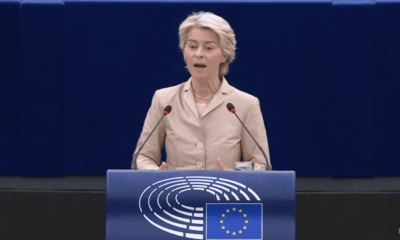Travel
Will this winter be good for skiing in Europe? Expert predictions on where will get snow this year
A ‘bleak future’ has been predicted for the ski industry – but will winter 2024/25 be an exception?
Europe’s ski resorts could face a ‘bleak future’, a report warned last week.
Warm and unpredictable weather has left slopes snowless in recent years – a trend that’s already impacting this winter’s ski season.
Yet another French resort recently took the tough decision to close its lifts for good after suffering a lack of snow, dwindling visitor numbers and growing debt.
French resorts aren’t the only ones struggling: high temperatures last February also left ski towns in Austria, Bosnia, Italy, Spain and Switzerland on their knees. Those at low and medium elevations were worst affected, leading to overcrowding at high-altitude resorts.
As we emerge from the hottest summer on record, is this downward spiral set to continue into winter 2024/25?
Here’s a look at this year’s ski season outlook in Europe.
Why are Europe’s ski resorts struggling?
Climate change is the prevailing factor behind Europe’s increasingly high temperatures. However, in 2024 this was supercharged by El Niño – a natural weather phenomenon in the Pacific Ocean where changes in pressure cause warm water to flow East, bringing with it excessive heat.
As we move out of this climate system, La Niña is expected to take over which, in contrast, has a cooling effect.
That could make this year’s winter cooler than the last – but will it be enough to boost Europe’s ski resorts?
According to the UK’s Met Office, La Niña could increase precipitation, potentially bringing heavier and more frequent snowfall. The weather system typically means a cold start and a mild end to winter in western Europe – so it could be best to get your ski holiday in early this year.
But since La Niña can be affected by other global climate drivers, it’s impact is hard to predict. A three-month indication released by Météo France last month gives only a 20 per cent likelihood that October to December will be cooler than usual versus a 40 per cent chance that it will be warmer than normal overall.
Even if conditions do improve this winter, it will be too late for some resorts buckling from years of waning snowfall.
Grand Puy and Alpe du Grand Serre in France have already had to close down this year due to piling economic losses.
Snow sports enthusiasts would be wise to opt for higher altitude resorts like Avoriaz, Tignes, Val d’Isère and Val Thorens in France, which are expected to open in late November.
For an earlier start, head to Finland’s Levi and Ruka ski resorts, which opened on 4 October, or Austria’s Kitzsteinhorn Glacier in Zell am See, which launched its winter season on 5 October.
Also in Austria, Sölden’s winter ski area is scheduled to open in mid-November and Ischgl’s typically long and reliable snow season is slated to begin at the end of November.
Diavolezza in Switzerland is expected to open on 19 October, while Cervinia – 2,050 metres up in the northwestern Italian Alps – is considered another ‘snow sure’ bet that’s set to open on 26 October.
Why you should take a ski train to the slopes
With climate change painting an unpredictable future for Europe’s ski resorts, it’s never been more important to consider the carbon footprint of your travels.
The energy and water resources needed to operate lifts, snow machines and hotels already make skiing a carbon-intensive activity.
But between 50 and 80 per cent of the industry’s emissions come from holidaymakers travelling to and from resorts.
Luckily, there’s a more sustainable option than flying: Eurostar Snow will operate ski trains to the French Alps from December.
Various other ski destinations can also be reached by rail, including Italy’s Cortina d’Ampezzo on the Espresso Cadore sleeper train.
Travel
‘Politically courageous’: EU postpones Entry/Exit System once again – but what’s behind it?
Ylva Johansson, the EU Home Affairs commissioner, had previously said with utmost confidence that the scheme would launch in November.
Following numerous delays, the EU’s planned Entry/Exit System (EES) for travellers outside the Schengen Area has been postponed once again.
Just a few weeks ago, the EU Home Affairs commissioner said with confidence that it would come into force on 10 November – or 17 November, as a backup.
Now, there is no official date for the launch and the whole scheme appears to have been plunged into chaos.
While commissioner Ylva Johansson said the ambitious electronic border plan would absolutely be in place next month, it’s now not likely to come into force until 2025.
On top of that, one aspect of the scheme – taking the fingerprints of travellers to guarantee entry into the area – may now be dropped entirely, although very little is clear.
The travel industry’s reaction has been mixed, with some saying the EU is leaving us all in “limbo”.
“It is good to know the full implementation of EES is no longer expected in November, as the industry has been left in limbo waiting for news on when it will start,” Luke Petherbridge, the Director of Public Affairs at ABTA – The Travel Association said in response.
“We do still need urgent confirmation and clarification on the next steps of EES; it’s difficult to talk to a customer about a new system without knowing if it will actually be in place for their trip.”
What caused this latest delay of the EES launch?
Speaking at a meeting of EU interior ministers on Thursday, Johannson said, “10 November is no longer on the table.”
“I hope we can start as soon as possible but there’s no new timeline so far. This also depends on the legal assessment that we will do and we’re working on it right now,” she added, also speaking of “some concerns when it comes to the resilience of the system”.
As an alternative, she proposed that the EU could potentially introduce the EES in a phased manner “with a little step by step going into the system, not a ‘Big Bang’ of all border crossing points at the same time”.
The floating of a ‘phasing in’ process would not be straightforward, as it isn’t allowed under current regulations. Instead, ‘targeted amendments’ to the legal text would be required to make it happen.
Johansson also noted that Germany, France and the Netherlands had declared their unreadiness for the EES.
The three nations, all major transport hubs in the EU, had previously expressed concerns over plans to go ahead with any system which had not been tested on ‘live’ border crossings.
Despite frustrations held by many, some experts say the delay is not necessarily a bad thing.
“Given the record of delays in introducing other more standard travel authorisation systems, the EES delays are not surprising,” Tim Wilson, a professor of criminal justice policy at Northumbria University Law School tells Euronews Travel, “I suspect that the challenge in making the EES work effectively is its comparative uniqueness.”
In fact, Wilson – who has given evidence to parliament on the use of electronic borders – thinks the delay might be a good thing – for now at least.
“It is a gain all round for passengers, border control agencies and the travel industry. In the meantime, for non-visa entry, the physical stamping of non-EU passports will continue.”
While the travel industry has invested hundreds of millions of euros into the scheme, many officials are said to be relieved about the delay, despite their expenditure.
That might have been a different story had the scheme been scrapped entirely, however.
“The IT and building expenditure is most unlikely to be a waste of money,” Wilson says. “Though greater transparency would help avoid the risk of unnecessary expenditure for travel operators, etc, on staff recruitment/training, and help the travelling public to plan future travel with greater confidence.”
It is, though, estimated that more than £100m (€120m) has been spent in the UK preparing for the start of the EES.
Delayed EES means more time to work on teething issues
Just this week, the Port of Dover – a main hub for travel out of the UK – started its work on a vast new canopy which will allow motorists to provide fingerprints and facial biometrics without holding up the flow of vehicles, queueing to board ferries to mainland Europe.
For now, authorities at the port may be breathing a sigh of relief.
Government officials representing Dover have repeatedly warned of a ‘worst-case scenario’ which could see delays of up to 14 hours affecting freight traffic, car and coach travel when the scheme is launched.
Some 68,000 coaches and 1.6 million cars pass through the port on a yearly basis, and there are concerns the system simply won’t be able to process everybody in a timely manner – although authorities say the new border control canopy will help to alleviate any issues.
Christina Brazier, Head of Industry Affairs at Association of Independent Tour Operators (AITO) is among those industry experts who is grateful for the delay.
“We welcome the European Commission’s decision to delay the implementation of the Entry/Exit System in light of the many unresolved questions and concerns raised by Member States,” she said.
“This announcement gives Member States valuable time in which to prepare and for the EU to clarify key outstanding issues. We fully support the proposal of a phased rollout, as it will allow the system to be thoroughly tested before full implementation.”
Wilson suggests that, despite some criticism, the EU’s decision to delay might actually be remembered as a sensible one.
“The politically courageous but honest decision to postpone until at least next year the launch of ESS is a textbook example of how programme delivery delays and unresolved problems should be handled,” he tells Euronews travel.
He adds that he hopes this latest delay will give EU officials “time to rethink how to ensure a realistic EES start date and avoid such a short notice cancellation again”.
What is the next step for the EES – and when might it actually launch?
Following the announcement of the delay, the EU’s Justice and Home Affairs Council is set to meet next week to discuss the EES rollout and lend some more clarity to those left in limbo.
It’s unlikely it will go ahead until the three nations – Germany, France and the Netherlands – are happy with the way it will work.
Speaking to Reuters news agency, a German interior ministry spokesperson said the three were not prepared to adopt the system as the EU agency in charge of it, called EU-Lisa, had not managed to make it stable enough to function.
The French interior ministry also told Reuters that the EES must be prepared properly before the country would go ahead with it.
The EES was initially supposed to start operating in 2022. It was then postponed until May 2023, then until the end of 2023 and finally, until 10 November.
The reasons for the delays have been blamed variously on IT issues and delays in installing automated barriers which will be required at all international land, maritime and air borders in the Schengen Area ahead of the launch.
‘Greater transparency’ on EES needed
Now, experts suggest that Johansson is wise not to have given a solid date for the launch.
“What everyone needs to see is greater transparency about progress towards implementation measured against key milestones,” Wilson says.
These, to him, include the improvement of “computer system resilience, availability of enrolment applications/kiosks, border staff training and availability, building availability/adaptation and readiness of carrier/port/airport staff and systems.”
Like many experts, though, he’s willing to bet that the scheme will go ahead at some point in the near future – rather than being scrapped entirely.
“In the present political climate [it wouldn’t be scrapped],” he says. “It is intended to give Schengen country police, etc, real-time data to prevent travel entry morphing into unauthorised migration. Some EES aspects might be optional, and a phased introduction might be possible.”
Nevertheless, the travel industry will no doubt be keen for some kind of steer on when they can expect the EES to finally come into force – although they could be waiting some time.
Travel
EU delays (again) new electronic system for border checks, floats phased-in approach
By Jorge Liboreiro & Video by Maria Psara
The Entry/Exit System is a comprehensive reform to modernise checks at the EU’s external borders and promote information-sharing.
The European Commission has decided to delay the introduction of the Entry/Exit System (EES), the bloc’s automated registry for short-stay travellers that was expected to come into force on 10 November.
The announcement was made by Ylva Johansson, the Commissioner for Home Affairs, at the end of a meeting of EU interior ministers on Thursday where the issue was discussed.
“10th of November is no longer on the table,” Johansson told reporters, noting that Germany, France and the Netherlands had declared their unreadiness.
“I hope we can start as soon as possible but there’s no new timeline so far. This also depends on the legal assessment that we will do and we’re working on it right now.”
Johannson spoke of “some concerns when it comes to the resilience of the system.”
As an alternative, she said, the EU could introduce the EES in a phased-in manner “with a little step by step going into the system, not a Big Bang of all border crossing points at the same time.”
However, that approach is not foreseen under the current regulation and “targeted amendments” to the legal text would be required to make it happen.
At any rate, she stressed, the gradual introduction would not start on 10 November.
What is the Entry/Exit System?
The EES is a comprehensive reform that dates back to 2016 and had been repeatedly delayed. Its main purpose is to modernise checks at the EU’s external borders and replace the traditional physical stamping of passports.
It will apply to non-EU citizens who come to the bloc for visits, holidays or business trips and stay for a total duration of up to 90 days within a 180-day period.
Once the system goes live, visitors will have to provide their passports on arrival, alongside having a photo of their face taken and their fingerprints scanned electronically.
All entries and exits from the passport-free Schengen Area will be recorded.
The collection of biometric data and the sharing of information in real time are meant to help authorities crack down on those who overstay their short-term visas and commit identity fraud.
All member states, except Cyprus and Ireland, and four Schengen-associate countries – Iceland, Liechtenstein, Norway and Switzerland – will take part in the scheme.
Passports in Cyprus and Ireland will continue to be stamped manually.
Travel
North Korea is trying to appeal to Russian tourists – but will its bizarre advert win them over?
The baffling advert, released by state-owned Korea International Travel Company, is the latest attempt to attract tourists to North Korea.
A North Korean tourism advert with low production values, near-empty beaches and cloudy skies has caught the internet’s attention.
The newly released advert features young, attractive people, who appear to be Russian, frolicking on a beach. It’s clearly aimed at potential tourists from Russia – but what’s not clear is whether or not it would attract any visitors.
The isolated Asian nation, not on many people’s travel bucket list, opened up to Russians earlier this year.
In February, around 100 tourists from Russia entered North Korea for a 4-day skiing excursion at the Masikryong Ski Resort. It was the first time since the pandemic that the country’s border had been opened.
Russian president Vladimir Putin, a close ally of North Korean leader Kim Jong Un, visited himself in June, with the pair signing a mutual aid agreement, in the event that either nation is attacked.
It was a sign that Russia and North Korea are continuing to strengthen their alliance, which has become closer in recent years.
What can we learn about tourism in North Korea from the advert?
North Korea’s advert was launched by the state-owned Korea International Travel Company and, surprisingly, has appeared on social media hub Reddit.
Said to be filmed at Majeon Beach in South Hamgyong Province in the east of the country, the video shows young Russians playing a competitive game of volleyball and swimming in the sea.
Others ride a jet ski through the waves and, for some reason, one woman indulges in a spot of shadowboxing.
The audio quality throughout is appalling, with most of the sound drowned out by a combination of static, crashing waves and noisy seagulls.
At one point, a couple talk to the camera but, due to a lack of microphones or subtitles, it’s hard to make out what they’re actually saying.
A Russian-speaking Euronews journalist managed to make out “Very beautiful sea, lots of…” and “Very clean beach, beautiful sea” – but not much else.
That’s not even the oddest thing in the advert. Women in bikinis are pictured throughout – despite the fact that it’s long been rumoured that skimpy swimwear is banned in the totalitarian country.
Experts, though, have suggested that North Korea may well turn a blind eye to foreigners wearing bikinis, and hold them to significantly lower standards than its own citizens, who live famously repressed and difficult lives.
Whether or not the advert will work remains to be seen, but it certainly seems as if it’s the latest step in a series of moves to promote Russian tourism in North Korea.
The mysterious nation has reportedly seen its GDP drop year on year, and could be in need of a financial injection from tourism.
There are even rumours that it plans to open up tourism to its biggest economic market of China in the near future.
-

 EU & the World3 days ago
EU & the World3 days agoTropical Storm Leslie’s Path: Where Is the Possible Hurricane Headed?
-

 Sports5 days ago
Sports5 days agoFrance vs. Israel without Kylian Mbappé, and Marcus Thuram is in doubt
-

 EU & the World3 days ago
EU & the World3 days agoDiddy’s Kids: Everything You Need to Know About His 7 Children and Their Mothers
-

 EU & the World3 days ago
EU & the World3 days agoIs Leslie Abramson Still in Contact With the Menendez Brothers?
-

 Politics5 days ago
Politics5 days agoHungary’s Role in Europe’s Future: Von der Leyen on Crisis, War, and Economic Growth
-

 EU & the World3 days ago
EU & the World3 days agoIs Orlando International Airport Open After Hurricane Milton?
-

 EU & the World6 days ago
EU & the World6 days ago‘A Complete Unknown’: Release Date, New Trailer & More on Timothee Chalamet’s Bob Dylan Biopic
-

 Sports6 days ago
Sports6 days agoTrento loses a piece: stop for Eigirdas Zukauskas








